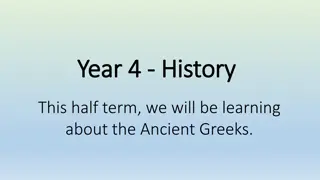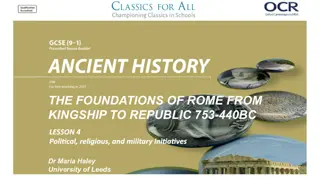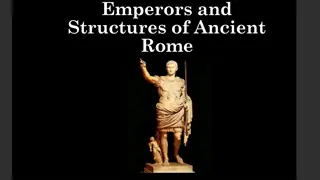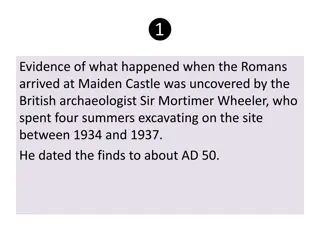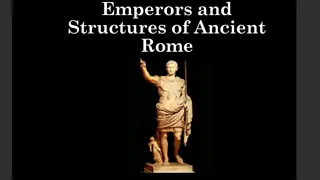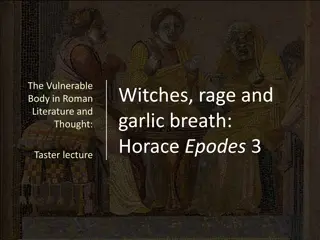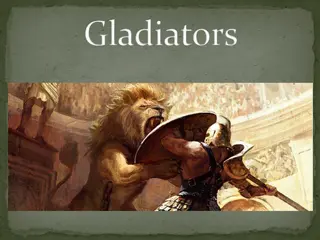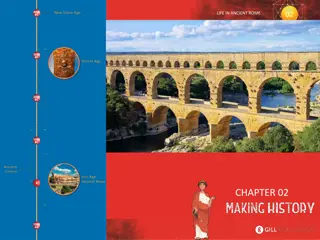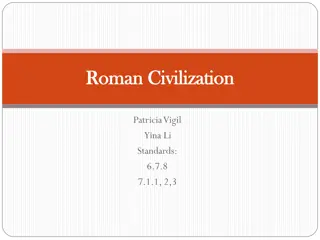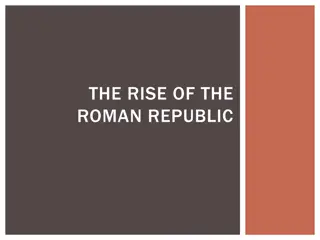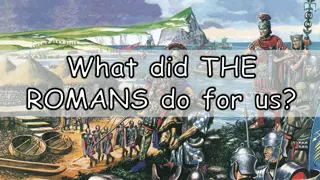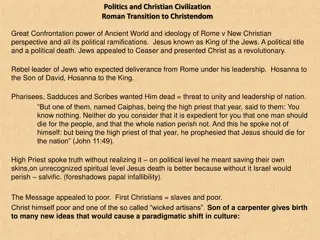Daily Life in Ancient Rome: A Glimpse into Roman Culture
Explore the morning routines, meal habits, clothing styles, and religious beliefs of ancient Romans. Discover how they lived, ate, dressed, and worshipped, shedding light on their fascinating lifestyle. Learn about the significance of family, societal structures, and deities in Roman society through an engaging perspective.
Download Presentation

Please find below an Image/Link to download the presentation.
The content on the website is provided AS IS for your information and personal use only. It may not be sold, licensed, or shared on other websites without obtaining consent from the author.If you encounter any issues during the download, it is possible that the publisher has removed the file from their server.
You are allowed to download the files provided on this website for personal or commercial use, subject to the condition that they are used lawfully. All files are the property of their respective owners.
The content on the website is provided AS IS for your information and personal use only. It may not be sold, licensed, or shared on other websites without obtaining consent from the author.
E N D
Presentation Transcript
Life in Rome Aim/Goals: How did the Romans live in ancient Rome? Do Now: What did you eat for breakfast today? What will you eat for lunch? Homework: Using the website provided below as a source www.memebers.aol.com/bkdonnclass/romel ife.html write a letter to your friend Mr. Pappas in Greece explaining how you live your daily life in ancient Rome.
WHAT DO YOU EAT? BREAKFAST LUNCH
Food ~~Breakfast~~ Ancient Romans who were poor would have a breakfast of bread ( dry or dipped in wine ), olives, cheese or raisins. Rich Romans would eat meat, fish, fruits, vegetables, bread and honey. Romans ate with their hands. * *Lunch** Lunch was usually a cold meal eaten about 11:00 A.M. It was bread, salad, olives, cheese, fruit, nuts and cold meat. After lunch the ancient Romans enjoyed a midday rest or siesta for 2 to 3 hours. Everybody took a nap and the streets were deserted. Even the kids got a 2 to 3 hour break from school.
Clothing Women wore and under tunic, stola, palla and gold embroidery. High ranking people wore a white tunic, purple tunic and gold embroidery. Common people wore tunics. Your toga showed how wealthy you were. Women loved jewelry and wore their hair up. Girls and boys wore a simple tunic down to their knees with a belt.
Document #1 Greek and Roman Gods and Goddesses Greek Name Roman Name Title Zeus Jupiter King of Gods Apollo Apollo God of Light Hermes Mercury Messenger of the Gods Poseidon Neptune God of the Seas Ares Mars God of War Hades Plato God of the Underworld Hera Juno Queen of the Goddesses Aphrodite Venus Goddess of Love and Beauty Athena Minerva Goddess of Wisdom Eres Cupid Goddess of Love Artimus Diana Goddess of Hunt 1. system? How do they differ? What do the Greeks and Romans have in common (similarities) in terms of their belief
Roman Religion was a function of Roman law. It was centered around the gods. They believed that gods controlled their lives. They spent a great deal of time worshipping the gods. The most important god was Jupiter. He was the king of the gods and ruled with his wife, Jund, the goddess of the sky. Other gods included, Mars, Mercury, Neptune, Diana, Minerva, and Venus. The picture above is the god Mercury
Document #2 Throughout its history, Romans valued discipline, strength, and loyalty. The family was the center of the Roman society. The oldest man in the family had complete authority (power) in the household. He controlled all the property too. The Romans made more use of slaves than any civilization before. Most slaves came from conquered (taken over) lands. Slaves worked in the city and on the farms. Some slaves were forced to become gladiators. Gladiators were professional fighters who fought to the death in public contests. Slaves did revolt (to go against) from time to time. None of these revolts succeeded (to do something that you planned). Your life in Rome depended on your social position. The wealthy ate well and enjoyed luxuries (good things). The poor including many people in Rome itself had no jobs and received food from the government. Housing was poor. People lived in constant danger of fire. To distract people from their problems, the government gave many celebrations. 2. The role of the oldest man in the household was _________________________________ __________________________________________________________________________. 3. Slaves came from _______________________________________________. Slaves in ancient Rome did ____________________________________________________________________________. 4. Gladiators are ______________________________________________________________________. 5. The life of wealthy Romans were they ___________________________________________________ ____________________________________________________________________________________. The poor Romans ______________________________________________________________________.
Housing Most Romans lived in Apartments called insulae. These were many stories high. Rich Romans also had a country house called a villa. They used the villa to escape from the noisy city of Rome. Most housing included a dining room, baths, bakery, kitchen, bedrooms, and a courtyard.
Two groups struggled for power in the new republic. One was the patricians, who were the aristocratic (rich) landowners who held most of the power. The other group was the plebeians, who were the farmers, artisans, and merchants who made up most of the population. At first, the patricians had the most power. Over time, the plebeians got the right to form their own assembly (group that voted for consul and tribunes). This will be discussed next. 6. The patricians were _________________________________________________________ ________________________________________________________. The plebeians were _________________________________________________________ _______________________________________________________. Who had the largest population (amount of people)?
Slaves Slaves were often treated badly in wealthy families. Slaves would be expected to cook, clean and do other jobs. Slaves would do women s jobs in wealthy homes. Men Men s work depended on where you lived. One important job was the administration of the empire. In the country side work was centered around the villa. Women Women cooked, cleaned, sewed, and maintained the house. Wealthy girls would spin wool, weave cloth, and sew.
W ealthy families would have a tutor for the boys. T hey would be taught public speaking. T his was very important. O ther subjects included, reading, writing, and counting. G irls were not taught the same skills as boys. T hey were taught by their mothers to spin wool, weave cloth and sew. P oor children were taught by their parents. S lave children had no education.
Document #4 Homework Assignment The next document is a primary source document. A primary source is a book, a document, an artifact, or another record that supplies firsthand information about a subject. Primary Source: A day in the Life of a Schoolboy I awoke before dawn; I arose from my bed; I sat down and put on my socks and shoes. I requested water for my face; I washed my hands first and then my face; I wiped them dry. I took off my sleeping clothes and put on my tunic; I did up the belt. I greased down my hair and combed it. I put a scarf around my shoulders. I left my bedroom with my pedagogue (slave) and nurse and went to greet my father and mother; I greeted them both and kissed them. Then I left home. I went to school. I entered and said, Hello teacher, and he kissed me and greeted me in return. My slave who carries my books handed me my waxed tablets, my writing box, and my writing instruments. Sitting in my place, I smoothed over the tablets. I printed the assigned sentence. When I finished I showed it to my teacher. He corrected it and wrote over my errors (mistakes). When we had finished the lesson, the teacher dismissed us for lunch. After being dismissed, I came home. I changed clothes and ate some white bread, olives, cheese, dried figs and nuts. I drank cold water. After lunch I returned to school. Source: Jo-Ann Shelton, As the Romans Did: A Sourcebook in Roman Social History (New York: Oxford University Press, 1988), 113-114. 7. Do you think this boy was well-off (rich) or poor? How can you tell? 8. What are the main differences between this boy s school day and your own? List at least three.




